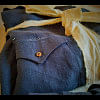Breaking barriers through arts and crafts

Outside the Bangladesh Investment Development Authority auditorium in Agargaon on June 12, a group of individuals with disabilities were seen working with dedication, responsibility, and passion.
Despite physical, intellectual, hearing or speech impairments, they were engrossed in their tasks -- making buttons, crafting tassels, knotting macrame ropes, crafting handmade jewellery, or embroidering cloth.
Inside the auditorium, a national seminar was underway discussing the National Skill Development Policy 2022, and how people with disabilities can be included in the labour force.
Although society often views those with disabilities as burdens, these individuals have proven that with proper education and training, they can earn a living and contribute to their homes too.
Khuki, who has short stature, was crafting tassels -- selecting colourful threads, cutting them to the appropriate length, bundling them together, and tying tight knots at the top. After smoothing and trimming the loose ends, she ensured they were tangle-free. Finally, she embellished the tassels with small beads and sequins for embellishment.
Ahead of Eid-ul-Azha, Khuki crafted over 2,500 intricate tassels, adorning garments such as dresses, kameezes, and sarees for the inclusive fashion brand Malancha, by Disabled Rehabilitation & Research Association (DRRA) Bangladesh.
Despite having an intellectual disability, Rizvy has mastered the art of button-making to such an extent that he produced 5,000 buttons for Eid-ul-Azha, earning the title of "expert of experts".
Reshma, a vocational trainer at the DRRA Bangladesh, highlighted Rizvy's impressive record. "If you ask him to create 250 buttons in one go, he can do it. For the Eid-ul-Azha production alone, he crafted around 5,000."
Bristy, who has a speech and hearing impairment, excels in hand stitching and embroidery. She uses a machine to create beautiful designs on runners, table mats, and dresses, among other items.
Tania, a mother with a speech and hearing impairment, specialises in beaded jewellery-making -- bracelets, necklaces, earrings, and ankle bracelets. Despite her challenges, Tania has become a skilled artisan, making significant contributions to her household income.
Setu, also with speech and hearing impairments, demonstrates her talent in macrame works and jute shikas and bags.
Reshma said, "They were all once students at DRRA Amarjyoti Special School. For those who have discontinued their studies, we provided skills training in handicrafts. This ensures they can earn a living and contribute to their families. Currently, we have 30 such students receiving training and contributing to our fashion brand, Malancha.
"It took considerable time to train them for these tasks, but their dedication has paid off. Without our disclosure, it's difficult to distinguish their work from anyone else's."
Unimart has partnered with DRRA to market and sell Malancha products, ensuring that these creations, made entirely by these talented individuals, reach customers across the city.
DRRA advisor Swapna Reza said over the past 15 years, they have trained around 3,000 persons with disabilities in various trades, helping them earn a living. Additionally, they have trained the family members as well to alleviate financial hardships.
"Along with this, we've been continuously advocating to different ministries to bring them to the mainstream, because the time for seeing this as charity work has passed. We must acknowledge that with proper education and training, they can perform like any other person and be included in the labour force," she said.
"It is necessary to monitor the tasks that persons with disabilities are performing after receiving training. It is essential to see how much work they can accomplish. Monitoring will help determine if additional training is needed and if any further accommodations are necessary."

 For all latest news, follow The Daily Star's Google News channel.
For all latest news, follow The Daily Star's Google News channel. 








Comments